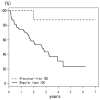Heterogeneous clinicopathological features of intraductal carcinoma of the prostate: a comparison between "precursor-like" and "regular type" lesions
- PMID: 24966964
- PMCID: PMC4069506
Heterogeneous clinicopathological features of intraductal carcinoma of the prostate: a comparison between "precursor-like" and "regular type" lesions
Abstract
Intraductal carcinoma of the prostate (IDC-P) has been described as a lesion associated with intraductal spread of invasive carcinoma and consequently aggressive disease. However, there are a few reported cases of pure IDC-P without an associated invasive component, strongly suggesting that this subset of IDC-P may represent a precursor lesion. We compared the clinicopathological features between the morphologically "regular type" IDC-P and "precursor-like" IDC-P. IDC-P was defined as follows; 1) solid/dense cribriform lesions or 2) loose cribriform/micropapillary lesions with prominent nuclear pleomorphism and/or non-focal comedonecrosis. We defined precursor-like IDC-P as follows; 1) IDC-P without adjoining invasive adenocarcinoma but carcinoma present distant from the IDC-P or 2) IDC-P having adjoining invasive microcarcinoma (less than 0.05 ml) and showing a morphologic transition from high-grade prostatic intraepithelial neoplasia (HGPIN) to the IDC-P. IDC-P lacking the features of precursor-like IDC-P was categorized as regular type IDC-P. Of 901 radical prostatectomies performed at our hospital, 141 and 14 showed regular type IDC-P and precursor-like IDC-P in whole-mounted specimens, respectively. Regular type IDC-P cases had significantly higher Gleason score, more frequent extraprostatic extension and seminal vesicle invasion, more advanced pathological T stage, and lower 5-year biochemical recurrence-free rate than precursor-like IDC-P cases. Multivariate analysis revealed nodal metastasis and the presence of regular type IDC-P as independent predictors for biochemical recurrence. Our data suggest that IDC-P may be heterogeneous with variable clinicopathological features. We also suggest that not all IDC-P cases represent intraductal spread of pre-existing invasive cancer, and a subset of IDC-P may be a precursor lesion.
Keywords: Prostate; high-grade prostatic intraepithelial neoplasia; intraductal carcinoma of prostate.
Figures


Similar articles
-
Clinicopathological analysis of intraductal proliferative lesions of prostate: intraductal carcinoma of prostate, high-grade prostatic intraepithelial neoplasia, and atypical cribriform lesion.Hum Pathol. 2014 Aug;45(8):1572-81. doi: 10.1016/j.humpath.2014.03.011. Epub 2014 Apr 12. Hum Pathol. 2014. PMID: 24842280
-
Atypical Intraductal Cribriform Proliferations of the Prostate Exhibit Similar Molecular and Clinicopathologic Characteristics as Intraductal Carcinoma of the Prostate.Am J Surg Pathol. 2017 Apr;41(4):550-556. doi: 10.1097/PAS.0000000000000794. Am J Surg Pathol. 2017. PMID: 28009609
-
Intraductal carcinoma of the prostate on needle biopsy: Histologic features and clinical significance.Mod Pathol. 2006 Dec;19(12):1528-35. doi: 10.1038/modpathol.3800702. Epub 2006 Sep 15. Mod Pathol. 2006. PMID: 16980940
-
Intraductal Carcinoma of the Prostate Gland: Recent Advances.Yonsei Med J. 2016 Sep;57(5):1054-62. doi: 10.3349/ymj.2016.57.5.1054. Yonsei Med J. 2016. PMID: 27401634 Free PMC article. Review.
-
Intraductal Carcinoma of the Prostate without High-Grade Invasive Adenocarcinoma: Report of Two Cases and Review of the Literature.Arch Esp Urol. 2022 Nov;75(9):738-745. doi: 10.56434/j.arch.esp.urol.20227509.108. Arch Esp Urol. 2022. PMID: 36472055 Review.
Cited by
-
Intraductal carcinoma of the prostate.Pathologica. 2020 Mar;112(1):17-24. doi: 10.32074/1591-951X-5-20. Pathologica. 2020. PMID: 32202536 Free PMC article. Review.
-
Genomic Features and Clinical Implications of Intraductal Carcinoma of the Prostate.Int J Mol Sci. 2021 Dec 4;22(23):13125. doi: 10.3390/ijms222313125. Int J Mol Sci. 2021. PMID: 34884926 Free PMC article. Review.
-
[Intraductal carcinoma of the prostate].Pathologe. 2016 Feb;37(1):27-32. doi: 10.1007/s00292-015-0138-4. Pathologe. 2016. PMID: 26782033 Review. German.
-
Cribiform and intraductal carcinoma in hereditary prostate cancer: clinical and pathological analysis of 20 cases.Am J Clin Exp Urol. 2024 Apr 15;12(2):100-109. doi: 10.62347/XOIN3964. eCollection 2024. Am J Clin Exp Urol. 2024. PMID: 38736618 Free PMC article.
-
Evaluation of tumor morphologies and association with biochemical recurrence after radical prostatectomy in grade group 5 prostate cancer.Virchows Arch. 2018 Feb;472(2):205-212. doi: 10.1007/s00428-017-2241-9. Epub 2017 Oct 3. Virchows Arch. 2018. PMID: 28975495
References
-
- McNeal JE, Yemoto CE. Spread of adenocarcinoma within prostatic ducts and acini. Morphologic and clinical correlations. Am J Surg Pathol. 1996;20:802–814. - PubMed
-
- Cohen RJ, McNeal JE, Baillie T. Patterns of differentiation and proliferation in intraductal carcinoma of the prostate: significance for cancer progression. Prostate. 2000;43:11–19. - PubMed
-
- Rhamy RH, Buchanan RD, Spalding MJ. Intraductal carcinoma of the prostate gland. J Urol. 1973;109:457–460. - PubMed
-
- Catalona WJ, Kadmon D, Martin SA. Surgical considerations in treatment of intraductal carcinoma of the prostate. J Urol. 1978;120:259–261. - PubMed
-
- Henry PC, Evans AJ. Intraductal carcinoma of the prostate: a distinct histopathological entity with important prognostic implications. J Clin Pathol. 2009;62:579–583. - PubMed
Publication types
MeSH terms
Substances
LinkOut - more resources
Full Text Sources
Medical
Miscellaneous
